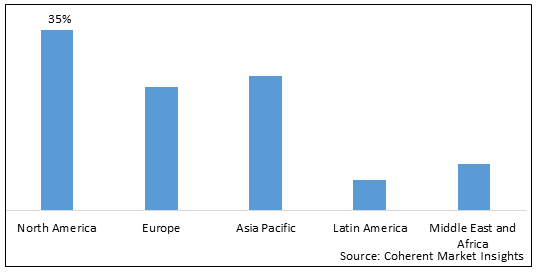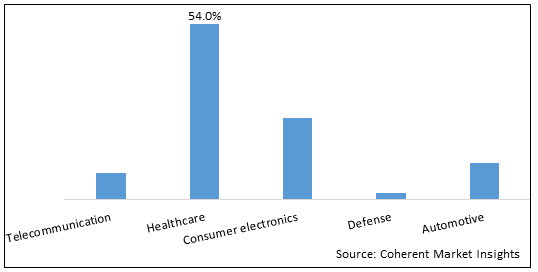Global Photodiode Sensors Market size was valued at US$ 778.2 Million in 2022, exhibiting a compound annual growth rate (CAGR) of 7.7% from 2023 to 2030. A photodiode is a PN-intersection diode that consumes light energy to deliver an electric flow. They are also known as a light detector, a photo Sensors, and a photo detector. Photodiodes are intended to function under conditions of reverse bias. Silicon, germanium, and indium gallium arsenide are typical photodiode materials. The photodiode Sensors market is expanding due to a number of key factors, including an increase in the use of barcode scanners for product billing in retail and other end-use industries. In addition, the demand for barcode scanners in the retail sector is increasing, which is a major contributor to the expansion of the photodiode Sensors market. This is because consumers are becoming more aware of the short processing time for purchase and billing transactions as well as the improvement in the impact of the customer experience in retail stores. Furthermore, standardized identification scanners assist stores with monitoring a huge volume of information of the exchanges performed.
Another factor contributing to the expansion of the Global Photodiode Sensors Market is the growing use of light/optical sensors in medical devices like pulse oximetry, medical imaging, and spectroscopic analysis. Likewise, expanding computerization across the medical care area for items, for example, clinical gadgets is pushing the interest for Photodiode Sensors.
Global Photodiode Sensors Market - Regional Analysis
Figure 1. Global Photodiode Sensors Market Share (%), By Region, 2022

To learn more about this report, request a free sample copy
North America is expected to dominate the global market during the forecast period, due to the increase in the end users of photodiode Sensors such as IT and telecommunication, healthcare, consumer electronics and transportation.
The increasing digitization within the APAC region with the introduction of 5G as well as IOT and rapid investments in the abovementioned sectors requires use of these photodiode sensors.
The European market sees a rise in the adoption of online education and remote working, which is leading to an increase in the electronic devices that is making use of these photodiode Sensors leading to their growth.
The Middle Eastern and African region is seeing an increase in these Sensors due to a rapid growth in commercial buildings as well as healthcare sector. These Sensors are being used in X-Rays, CAT Scanners and Pulse Oximeters, which drives the market growth.
Global Photodiode Sensors Market- Segmentation
Healthcare segment held significant market share in Global Photodiode Sensors market. The Medical Equipment includes Pulse Oximeters and X-Ray and CAT scanners. Through a scintillator crystal, the X-rays become light, and the photodiodes measure the intensity of the light. Imaging applications such as x-ray scans of body parts and CT scans for medical imaging make use of Photodiodes to clearly view the results of these tests. Photodiodes are extremely useful components for a variety of uses. They are an excellent choice for optoelectronic systems and devices that require low-light detection due to their ability to convert light into electrical current.
Figure 2. Global Photodiode Sensors Market Value (US$ Mn) Analysis and Forecast, By Application, 2022

To learn more about this report, request a free sample copy
The Global Photodiode Sensors Market is valued at US$ 778.18 million in 2022 and expected to reach US$ 1,404.70 million by 2030, exhibiting a CAGR of 7.70% between 2023 and 2030.
Global Photodiode Sensors Market - Key Competitors
Key industry participants in the Global Photodiode Sensors Market Key players operating in the market include EVERLIGHT ELECTRONICS CO., LTD., First Edmund Optics Inc., Harting Technology, KYOTO SEMICONDUCTOR Co., Ltd., OSRAM International GmbH., ROHM CO., LTD., Sensors AG, Thorlabs, Inc., TT Electronics, and Vishay Intertechnology, Inc. among others.
Global Photodiode Sensors Market - Recent Developments
Photodiode Sensors Market Report Coverage
| Report Coverage | Details | ||
|---|---|---|---|
| Base Year: | 2022 | Market Size in 2022: | US$ 778.2 Mn |
| Historical Data for: | 2018 to 2021 | Forecast Period: | 2023 to 2030 |
| Forecast Period 2023 to 2030 CAGR: | 7.7% | 2030 Value Projection: | US$ 1,404.8 Mn |
| Geographies covered: |
|
||
| Segments covered: |
|
||
| Companies covered: |
EVERLIGHT ELECTRONICS CO. LTD., First Edmund Optics Inc., Harting Technology, KYOTO SEMICONDUCTOR Co., Ltd., OSRAM International GmbH., ROHM CO., LTD., Sensors AG, Thorlabs, Inc., TT Electronics, and Vishay Intertechnology, Inc. |
||
| Growth Drivers: |
|
||
| Restraints & Challenges: |
|
||
Global Photodiode Sensors Market – Drivers
Rising utilization of the avalanche photodiode Sensors will help the market development
Avalanche photodiodes (APDs) are photodetectors with a gain mechanism that convert light into energy through the photoelectric effect. Numerous industries make use of the avalanche photodiodes, which are made from silicon, InGaAs, and germanium. The avalanche photodiodes market is developing because of the gadget's application in medication. For instance, as on September 2022, according to MedTech Europe, the annual growth rate for sales of medical equipment in Europe was estimated to be grow at around 2.9% in 2021. Compared to other types, silicon-based avalanche photodiodes are less expensive and have a wavelength range of 450 to 1000 nm, with a peak sensitivity of 600 to 800 nm.
Increasing use in the automotive industry is driving market expansion
Photodiode Sensors are used in automobiles because they can send a signal to the system to adjust the brightness of the display lighting when they detect sunlight entering the vehicle. Downpour Sensors situated behind the windshield count the quantity of drops that have arrived on a given area and in this manner enact the suitable wiper activity utilizing photodiodes. The photodiode market will see significant expansion in the near future as a result of the rising demand for electric and hybrid automobiles as well as the accelerating growth rate of global automotive vehicles. As per the IEA, 11.3 million electric battery vehicles were sold worldwide in 2021, over two times as many as were sold in 2020. As photodiode Sensors are generally introduced in numerous auto vehicle modules. For example, LiDAR frameworks, load levelers in extravagance cars, security cautioning frameworks, the business' quick development will likewise increment interest for these Sensorss. As the development of engine vehicles in the business will expand the interest for photodiode Sensors will likewise increment. The data from the OICA (Organisation Internationale des Constructeurs d'Automobiles) show that total vehicle production has increased by 3%, rising from 77,711,725 units in 2020 to 80,145,988 units in 2021. The use of laser technology and Sensors automation has increased as a result of the increased production of high-end automobiles. (https://www.knowledge-sourcing.com/report/photodiode-Sensorss-market)
Global Photodiode Sensors Market – Restraints
High cost of integration and Poor Temperature stability
There might be a fault with the thermostat which regulates the temperature. In addition, your refrigerator equipment could also have dirty fans, a faulty compressor, refrigerant leaks, or limited airflow. Semiconductor computerization frameworks should have the option to control wafer manufacture all through its many advances, which should persistently change despite developing requests put on Photodiodes themselves. Because of this, automation systems are under constant pressure to adjust the numerous steps in the fabrication process. To ensure that their automation frameworks remain on top of tuning-wafer fabrication and other processes, semiconductor manufacturers must not stop investing in human and artificial intelligence oversight. Automation, even though is a highly costly investment, must be done for sustainability.
Supply Chain Disruption
Indeed, even before the pandemic, a quick expansion popular for semiconductors was overburdening the assembling limit and operations of the semiconductor business. In a number of ways, COVID-19 dramatically increased that strain. Due to an overall disruption of supply chain networks across the globe, it was increasingly difficult to cater to companies who needed photodiodes and semiconductors. Several medical, automotive and electronic manufacturing companies rely on photodiodes for their product functioning. A global level disruption of warehousing and transportation, either delayed or cancelled the deliveries of several of these photodiodes, rendering clients vulnerable
Global Photodiode Sensors Market– Opportunity
Increased use of Smartphones
Increasing standard of living across several developing countries is increasing the use of smartphones. According to CMI Analysts, There are roughly 7 billion smartphone users across the world. That is around 86% of the global population, as of 2023. This is a key driver and opportunity for Photodiodes and Photodiodes to ramp up production and cater to these requirements. According to statista.com, the overall smartphone users across the globe shall increase to around 7.7 billion users by the year 2027. This means there is a huge opportunity for photodiode and semiconductor manufacturing companies to increase their production.
Growth of Healthcare Sector
According to niti.gov, India's healthcare industry has been growing at a Compound Annual Growth Rate of around 22% since 2016. Healthcare has become one of the largest sectors across the country, which means there is also a rise in the medical equipment used by the hospitals and health care units. In recent years, there has been a growing demand for diagnostic devices in the healthcare sector. A photodiode is mainly used in medical instruments to measure oxygen concentration in blood. Avalanche photodiodes (APDs) are silicon-based solid-state detectors that convert photons into charged currents. They provide a compact, robust, magnetic field insensitive solution for light and x-ray detections with 100 and fast response time gains. Due to this, APDs are extensively used in the healthcare sector. In this sector, APDs are useful due to their several benefits, including fast response time, high performance, and longer life.
Global Photodiode Sensors Market- Impact of Coronavirus (Covid-19) Pandemic
Since the beginning of the pandemic, numerous industries around the world have suffered. This can be attributed to the significant disruptions that their respective manufacturing operations and supply chains experienced as a result of various precautionary lockdowns and other restrictions enforced by global government authorities in response to the COVID-19 pandemic.
The equivalent likewise applies to the worldwide photodiode Sensors market. Additionally, consumer demand has decreased as a result. Because the COVID-19 outbreak has had such a significant impact on the general economic situation of the majority of people, individuals are now more focused on cutting out unnecessary expenses from their respective budgets. These previously mentioned components are supposed to trouble the pay direction of the worldwide photodiode Sensors market throughout the estimate time span. However, the global photodiode Sensors market is anticipated to recover as the respective governing authorities begin to lift these enforced lockdowns.
*Definition: A photodiode is a PN-junction diode that consumes light energy to produce an electric current. They are also called a photo-detector, a light detector, and a photo-Sensors. Photodiodes are estimation gadgets that produce electrical signs because of different kinds of high-recurrence electromagnetic radiation — ambient light, light focused by a camera lens, laser signals used in communication systems and thermal emissions.
Frequently Asked Questions
Joining thousands of companies around the world committed to making the Excellent Business Solutions.
View All Our Clients